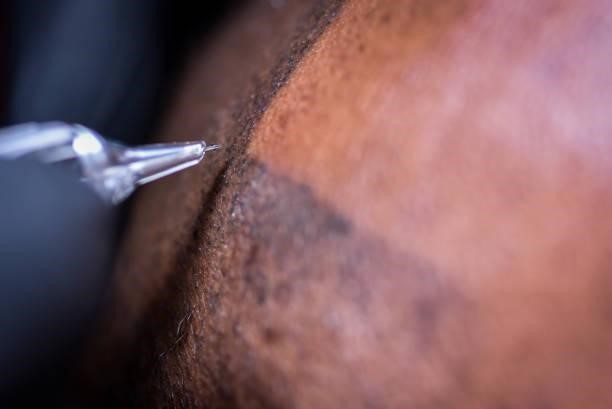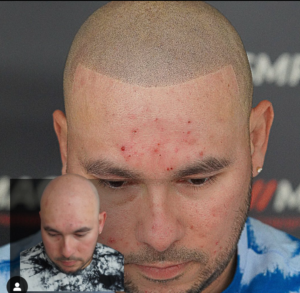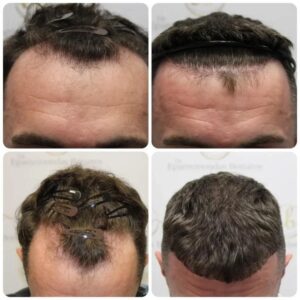So you’ve decided to get a hair transplant. You’re not alone – hair loss affects up to 85 percent of men and 40 percent of women. In fact, according to a recent report there has been a 43.3% increase in the number of Google searches for “hair transplant” since 2017. Wondering why is scalp micropigmentation better than a hair transplant?
But what if there was another option? Scalp micropigmentation (SMP) has been growing in popularity as an alternative to a hair transplant (HT), and for good reason – SMP can give you the same results as a hair transplant without the pain, expense, and time commitment.
So, which is better, scalp micropigmentation or a hair transplant? Let’s take a look.
Table of Contents
Key Takeaway:
There are a few key reasons why scalp micropigmentation is often seen as a better option than a hair transplant, even though both can restore the appearance of a full head of hair.
The principal reasons why scalp micropigmentation might be preferable to a hair transplant:
- SMP is less expensive
- SMP is less invasive
- SMP has fewer side effects
- SMP can be completed in a day, while a transplant takes months to heal
- There’s no downtime after SMP, while transplants require weeks of recovery.
What is Scalp Micropigmentation?
Scalp micropigmentation is a cosmetic treatment that involves depositing pigment into the scalp to create the appearance of full head of hair. The pigments used in SMP are typically made from iron oxide, which is safe for use on the skin.
The treatment is performed using a specially designed device that resembles a tattoo machine. The needles used in SMP are much smaller than those used in traditional tattooing, and they deposit pigment into the upper dermis rather than the deeper layers of skin.
Scalp micropigmentation is considered a semi-permanent solution for hair loss, as the pigments do gradually fade over time. However, touch-ups can be performed to maintain the results indefinitely.
What is a Hair Transplant?
A hair transplant is a surgical procedure in which hair is removed from one area of the scalp and transplanted to another. The most common type of HT is called follicular unit transplantation, or FUT.
This procedure removes a strip of skin containing hair follicles from the donor area, typically at the back of the head. The individual follicles are then transplanted to the area where hair loss has occurred, most often the top or front of the head.
Hair transplants can also be performed using follicular unit extraction or FUE. In this procedure, individual hair follicles are harvested from the donor area and transplanted to the site of hair loss. While FUT may yield better results in terms of density and coverage, FUE is less invasive and has a shorter recovery time.
Ultimately, the best choice for a hair transplant procedure depends on the patient’s goals and circumstances.
Differences Between Scalp Micropigmentation and Hair Transplants
There are a few key differences between scalp micropigmentation and hair transplants. First, scalp micropigmentation is much less invasive. The treatment can be performed in a single session, and there is no need for anesthesia or stitches.
Second, scalp micropigmentation is a fraction of the cost of a hair transplant. A typical scalp micropigmentation treatment can cost between $1,800 and $4,000, while hair transplant surgery (hair restoration surgery) can cost between $4,000 and $15,000.
Third, scalp micropigmentation produces immediate results, while it can take up to 12 months to see the full results of a hair transplant.
Fourth, scalp micropigmentation is semi-permanent, while the results of a hair transplant are permanent.
Finally, scalp micropigmentation can also be used to cover up scarring from previous hair transplants.

Why is Scalp Micropigmentation Better than a Hair Transplant?
There are two main ways to address hair loss: scalp micropigmentation and hair transplants. Both have their advantages and disadvantages, but scalp micropigmentation is generally considered the better option. Scalp micropigmentation vs. hair transplant; here’s some comprehensive comparisons:
1. Invasiveness and Risk:
- SMP: SMP is significantly less invasive than a hair transplant. It does not involve surgical procedures or incisions, eliminating the risk of surgical complications like infections, excessive bleeding, or nerve damage.
- Hair Transplant: Hair transplant surgery involves the extraction of hair follicles from one part of the body (usually the back of the head) and their transplantation to the balding areas. This surgical approach carries inherent risks associated with any surgical procedure.
2. Cost-Effectiveness:
- SMP: SMP is generally more cost-effective than a hair transplant. The latter typically involves multiple sessions, each with its associated costs, making it a substantially more expensive option in the long run.
- Hair Transplant: Hair transplants can be prohibitively expensive for many individuals, particularly when considering the need for multiple sessions to achieve desired results.
3. Convenience:
- SMP: SMP offers greater convenience as there is no need for extended recovery periods or time off work. The procedure can often be completed in a shorter timeframe compared to hair transplant surgeries.
- Hair Transplant: Hair transplant surgeries require patients to take time off work, and they may experience discomfort and post-operative recovery periods.
4. Natural-Looking Results:
- SMP: SMP is renowned for its ability to deliver highly natural-looking results. Pigments are skillfully placed in the upper dermal layer of the skin, closely resembling the appearance of natural hair follicles and blending seamlessly with existing hair. This creates a 3D effect that is remarkably convincing.
- Hair Transplant: While hair transplants can yield natural results, there is still a possibility of a visible linear scar where the donor hair is extracted, and the results may not appear as uniform or subtle as those achieved with SMP.
5. Scarring:
- SMP: SMP does not result in any noticeable scarring, as it does not involve surgical incisions or tissue removal.
- Hair Transplant: Hair transplant procedures can leave behind scars, particularly if the FUT (Follicular Unit Transplantation) method is used, which involves removing a strip of skin from the donor area. Even with the FUE (Follicular Unit Extraction) method, tiny puncture scars may be visible. Here’s a comprehensive guide on hair transplant scars.
6. Long-Term Solution:
- SMP: SMP offers a permanent solution for hair loss. The pigments remain stable and do not require any ongoing maintenance, providing a consistent appearance.
- Hair Transplant: Hair transplants can be long-lasting, the transplanted hair may still thin or fall out over time, necessitating potential follow-up surgeries to maintain the desired density.
It is safe to infer from the above that scalp micropigmentation is generally regarded as a safer, more cost-effective, and convenient solution for hair loss when compared to hair transplants.
The natural-looking results, absence of scarring, and permanence of SMP make it an increasingly popular choice for individuals seeking a non-surgical yet highly effective remedy for their hair loss concerns.
FAQS
Can you have a hair transplant after micropigmentation?
Yes, you can absolutely have a hair transplant after undergoing scalp micropigmentation. In fact, some people choose to combine these procedures for a fuller and more natural-looking result. SMP can be used to densify the transplanted hair follicles, creating a more realistic hairline and scalp coverage. However, it’s important to consult with both the SMP practitioner and hair transplant surgeon to ensure proper planning and timing between the procedures.
Is SMP cheaper than a hair transplant?
Generally, scalp micropigmentation is significantly cheaper than a hair transplant. While the cost of SMP can vary depending on the experience of the practitioner and the size of the area treated, it’s typically several times less expensive than hair transplant surgery.
How long does scalp micropigmentation last?
Scalp micropigmentation is a long-lasting cosmetic procedure but is not entirely permanent. The pigments typically fade over time, requiring touch-up sessions every few years to maintain the desired density and color. Factors like sun exposure and skin type can also influence how long the results last.
Can hair grow over micropigmentation?
Yes, your existing hair can grow through and over the micropigmentation without issues. SMP can be used to camouflage thinning hair by creating the illusion of a denser head of hair.
Do people regret scalp micropigmentation?
Scalp micropigmentation has a high satisfaction rate, but as with any cosmetic procedure, there’s always a chance for regret. Choosing a qualified practitioner who uses high-quality pigments and techniques to achieve natural-looking results is crucial. Researching before and after photos and thoroughly discussing your desired outcome with the practitioner can help minimize the risk of dissatisfaction.
Do any celebrities have scalp micropigmentation?
Yes, many celebrities have undergone scalp micropigmentation and even hair transplants. We recently compiled a list of the top 10 celebs with SMP. Check them out!
Can you tell if someone has scalp micropigmentation?
When done well, scalp micropigmentation should be very natural-looking and difficult to detect. However, poorly applied SMP with unnatural pigment colors or unrealistic hair patterns might be noticeable in some cases.
Who should not get scalp micropigmentation?
People with certain skin conditions like keloids (raised scar tissue) or uncontrolled eczema shouldn’t undergo SMP. Additionally, those with bleeding disorders or who are on blood-thinning medications may not be suitable candidates. It’s always best to consult with a doctor before getting any cosmetic procedure.
Conclusion
Scalp micropigmentation and hair transplants are both effective solutions for hair loss. However, scalp micropigmentation is generally the more desirable option due to its safety, affordability, convenience, and natural-looking results.
If you’re considering your options, be sure to consult with a qualified scalp micropigmentation specialist to see if it’s right for you.




